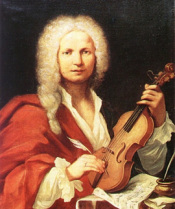Cooking at the Ospedali
June 24, 2006
__________________________________________________________
Antonio VivaldiOnly a smallish crowd turned out on Thursday night for the Washington Early Music Festival; maybe due to the 92+ heat, maybe due to some natural limit on the amount of early music one town can absorb in two weeks. The Countertop Ensemble put on a long, somewhat effortful concert, led with great determination by mezzo Marjorie Bunday. We left feeling a bit over-cooked, and drove home in the haze to find Toby barking crazily out the window at the heat lightning. Some kind of metaphor for music criticism? Here's the review:
The Washington Post 6/24/06: One of the most intriguing musical fixtures of the 18th Century was the group of orphanage-conservatories in Venice known as the Ospedali. Set up as havens for abandoned children, they evolved into top-flight music schools for girls, and produced choruses so renowned that composers of the day fell all over each other to write for them.
The result was one of the most extraordinary (and little-explored) treasure-troves of Baroque music in existence, and on Thursday night at St. Mark’s Episcopal Church (as part of the Washington Early Music Festival), the Countertop Quartet and the Baroque Band dove deeply into it. The Countertop is an unusual group; with soprano, mezzo and two high-pitched male counterternors, the group specializes in music for upper voices. Perfect for the Ospedali repertoire, you’d think. And the ensemble gave some fascinating, and at times quite beautiful, readings of works by Nicola Porpora, Antonio Vivaldi, and other composers associated with the schools.
But the concert didn’t quite take off; this is music for light young female voices, and the more spartan, more aged, and definitely more masculine Countertop lacked the sweetness of tone to bring out its full translucent beauty. Despite some thoughtful musicianship, the ensemble also seems to have some teething problems (primarily balancing the voices and achieving a unified sound) and there was a troubling lack of dynamic and textural contrast – crucial to making polyphony like this really sing.
The most convincing piece on the program, in fact, was purely instrumental: Vivaldi’s variations on “La Folia”, Op. 1 No. 12. The Baroque Band – featuring Garry Clarke and Timothy Haig on violins, with Alice Robbins on cello – delivered a riveting, cut-to-the-bone performance, every note crackling with purpose and electricity.


Reader Comments